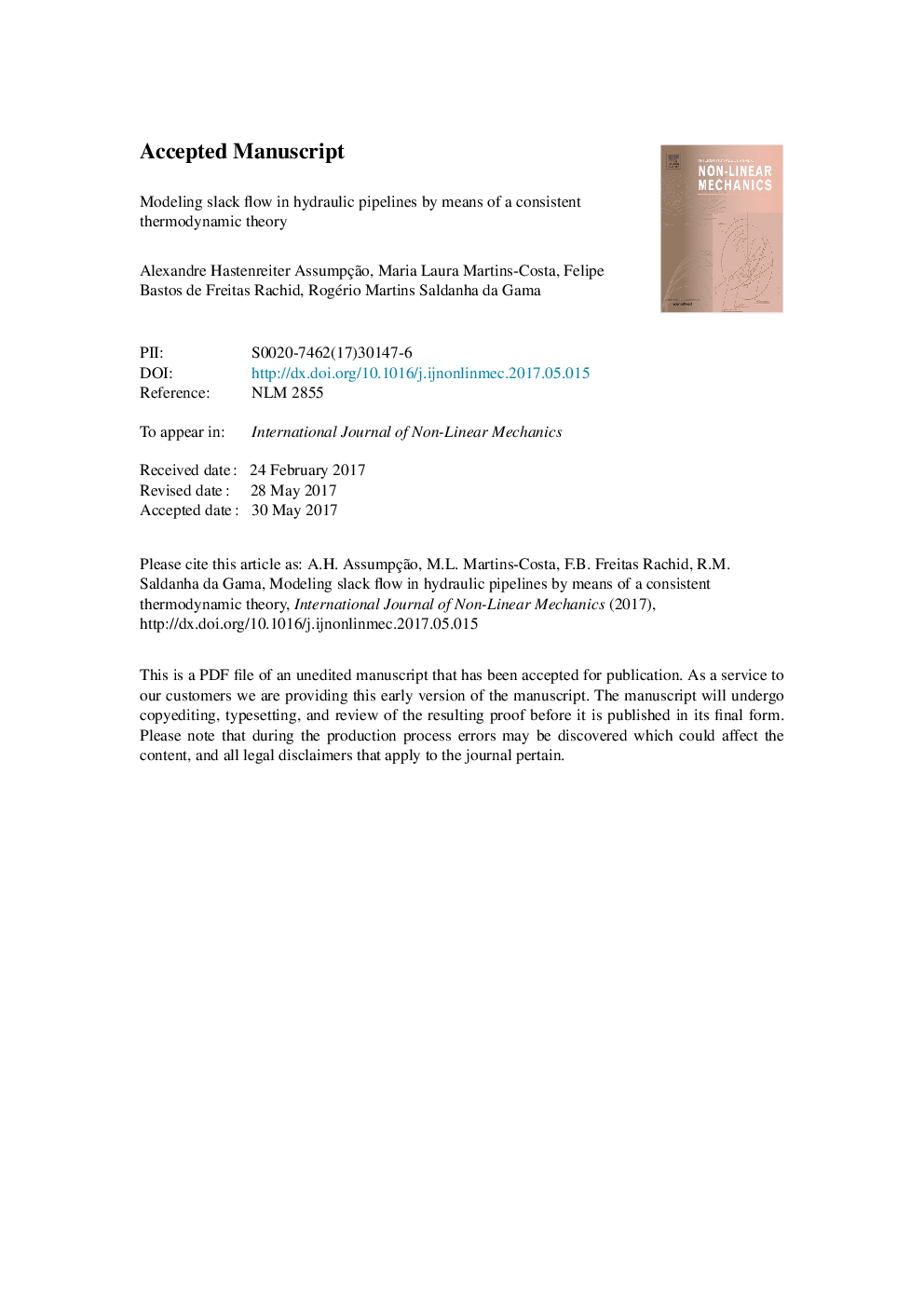| کد مقاله | کد نشریه | سال انتشار | مقاله انگلیسی | نسخه تمام متن |
|---|---|---|---|---|
| 5016492 | 1465300 | 2017 | 55 صفحه PDF | دانلود رایگان |
عنوان انگلیسی مقاله ISI
Modeling slack flow in hydraulic pipelines by means of a consistent thermodynamic theory
ترجمه فارسی عنوان
مدل سازی جریان شل در خط لوله های هیدرولیکی با استفاده از نظریه ترمودینامیکی سازگار
دانلود مقاله + سفارش ترجمه
دانلود مقاله ISI انگلیسی
رایگان برای ایرانیان
کلمات کلیدی
کاویتاسیون بخار گاز بی اثر، گاز رایگان، تغییر فاز غیر قابل برگشت ترمودینامیک فرآیندهای غیرقابل برگشت
ترجمه چکیده
این کار یک مدل ترمودینامیکی سازگار را برای توصیف جریانهای حفره ای در خطوط لوله هیدرولیکی ارائه می دهد. اگر چه مدل قادر است پدیده کاویتاسیون تبخیر را در حالت های نامنظم و همچنین حالت پایدار توصیف کند، کاربردی که در اینجا ارائه شده است، محدود به شرایط جریانی است که تحت حالت پایدار قرار می گیرد. جریان تصور می شود همگن و ایزوترمال است و مایع به عنوان یک شبه مخلوط، شامل مایع، بخار و گاز بی اثر است. اجزای سازنده فرض می شود که فشرده می شوند و در هر لحظه و لحظه ای همکاری می کنند. تعادل معادلات جرم برای هر مولفه در مدل در نظر گرفته شده است، همراه با یک معادله تعادل از مولفه برای مخلوط به عنوان یک کل، همه آنها در متن یک بعدی. وجود مقدار کمی گاز بی اثر با بخار، شرایط ترمودینامیکی لازم برای توصیف باز و بسته شدن حفره را تضمین می کند. این همچنین اجازه می دهد تا توصیف پدیده کاویتاسیون بخار در هر منطقه از دامنه جریان سیال را با استفاده از یک مجموعه معادلات مشابه. دگرگونی تغییر فاز به درستی به عنوان یک فرآیند برگشت پذیر تبدیل شده است. نتایج به دست آمده با استفاده از شبیه سازی های عددی ساده در حالت پایدار نشان می دهد که مدل قادر است به طور انعطاف پذیری باز و بسته شدن حفره ها را توصیف کند تا زمانی که جریان صوتی نمی شود.
موضوعات مرتبط
مهندسی و علوم پایه
سایر رشته های مهندسی
مهندسی مکانیک
چکیده انگلیسی
This work presents a consistent thermodynamic model to describe cavitating flows in hydraulic pipelines. Although the model is capable to describe the vaporous cavitation phenomenon in unsteady as well as steady regimes, the application presented herein is restricted to slack flow condition, which takes place under steady state. The flow is assumed to be homogeneous and isothermal and the fluid is regarded as a pseudo-mixture, comprising the liquid, its vapor and an inert gas. The constituents are assumed to be compressible and to coexist at every material point and time instant. The balance equations of mass for each constituent are considered in the model, along with one balance equation of momentum for the mixture as a whole, all of them within the one-dimensional context. The existence of a small amount of inert gas along with the vapor ensures the necessary thermodynamic condition to describe the opening and closing of the cavity. It also allows the description of the vaporous cavitation phenomenon in any region of the fluid flow domain by means of a same set of equations. The phase change transformation is properly accounted for as an irreversible process. The obtained results by means of simple numerical simulations in steady state show that model is capable to coherently describe the continuous opening and closure of the cavities as long as the flow does not become sonic.
ناشر
Database: Elsevier - ScienceDirect (ساینس دایرکت)
Journal: International Journal of Non-Linear Mechanics - Volume 95, October 2017, Pages 82-92
Journal: International Journal of Non-Linear Mechanics - Volume 95, October 2017, Pages 82-92
نویسندگان
Alexandre Hastenreiter Assumpção, Maria Laura Martins-Costa, Felipe Bastos de Freitas Rachid, Rogério Martins Saldanha da Gama,
